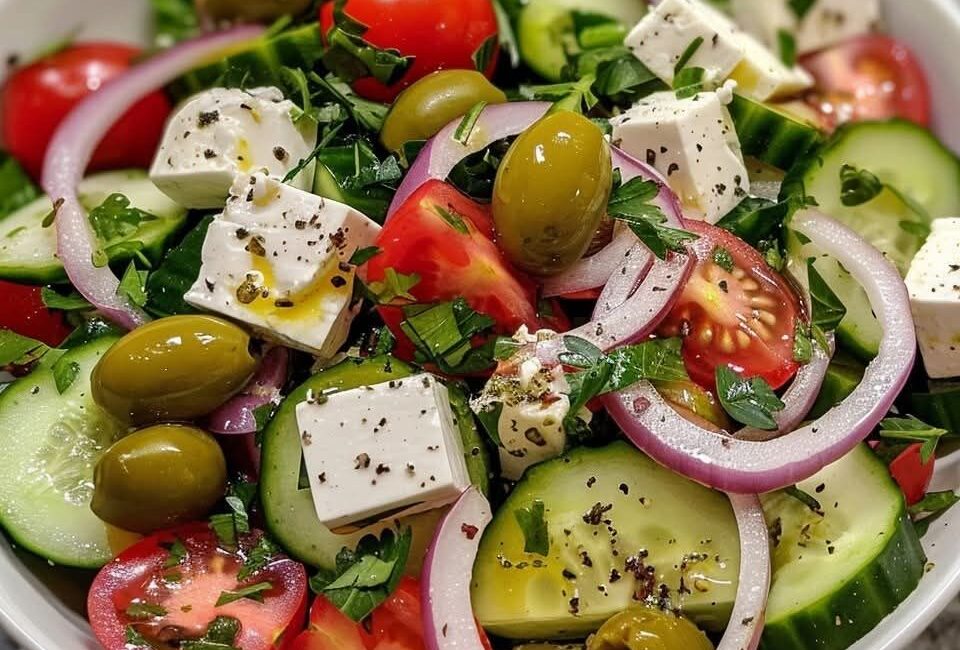The Classic Greek Salad, also known as Horiatiki, is a timeless Mediterranean dish that captures the essence of Greek cuisine in its simplest form. With its fresh, vibrant ingredients, this salad is both a refreshing treat and a healthy addition to any meal. It’s a perfect side dish for hot summer days, an appetizer for gatherings, or even a light main course. Whether you’re enjoying it in a sunny Greek village or preparing it at home, this salad offers a delicious and nourishing experience that’s hard to beat.
In this article, we’ll dive deep into the origins, ingredients, preparation, and variations of the Classic Greek Salad. We’ll also share tips and tricks to enhance your salad experience and make it truly your own. Let’s get started!
The Origins of the Classic Greek Salad
The Greek Salad is a staple of Greek cuisine, offering a perfect balance of simple ingredients, flavors, and textures. Traditionally known as Horiatiki in Greek, which translates to “village salad,” this dish is closely tied to Greece’s agricultural heritage. It is a representation of fresh, local produce, combined with the essential flavors of Greek cooking—extra virgin olive oil, feta cheese, and oregano.
The salad has evolved over the years, but its essence remains the same: a combination of fresh vegetables, olives, feta cheese, and a dressing of olive oil and vinegar. The dish is typically served without lettuce, making it stand out as a robust, vegetable-heavy salad with a lot of character.
Ingredients for the Classic Greek Salad
The beauty of this salad lies in the simplicity of its ingredients. Each component is carefully selected for its fresh taste, texture, and nutritional value. Here’s what you’ll need:
- 2 cups cucumber, sliced: Cucumbers provide a crisp, refreshing base for the salad. Their mild flavor complements the sharper tastes of the onions and olives, and their high water content helps keep the salad hydrating.
- 1 cup cherry tomatoes, halved: These sweet, juicy tomatoes are a staple in Greek salads. They add a burst of color and flavor, balancing the slightly tangy dressing with their natural sweetness.
- 1/2 red onion, sliced: Red onions offer a sweet yet slightly sharp flavor. When sliced thinly, they provide a subtle crunch that enhances the overall texture of the salad.
- 1/4 cup Kalamata olives: These dark purple olives are known for their rich, briny flavor. They’re iconic in Greek cuisine and add a salty, tangy punch to the salad.
- 1/4 cup green olives: Green olives offer a firmer texture and a slightly milder taste than Kalamata olives. They balance out the richness of the feta cheese and provide an additional depth of flavor.
- 1/2 cup feta cheese, cubed: Feta is a hallmark of Greek cuisine, and it’s what truly makes a Greek salad stand out. The salty, creamy texture of feta pairs beautifully with the vegetables and olives, adding a richness that ties everything together.
- 1 tbsp fresh parsley, chopped: Parsley adds a fresh, herbaceous note to the salad. It also brightens up the dish visually with its vibrant green color.
- 1/4 tsp dried oregano: Oregano is a quintessential Greek herb that adds depth and earthiness to the salad. It complements the flavors of the tomatoes, olives, and feta cheese, providing an aromatic essence that’s characteristic of Mediterranean cuisine.
- Salt & pepper, to taste: A little seasoning goes a long way. Salt enhances the flavors of the fresh ingredients, while pepper adds a gentle kick to the dressing.
- 2 tbsp olive oil: Olive oil is the heart of Greek cooking, and it serves as the base for the salad dressing. Its rich, fruity flavor brings everything together, making the vegetables and cheese shine.
- 1 tbsp red wine vinegar: Red wine vinegar adds acidity to the dressing, balancing out the richness of the feta and olives. The tanginess is essential for cutting through the fattiness of the olive oil and creating a harmonious flavor profile.
Step-by-Step Instructions for Making Classic Greek Salad
Now that we’ve gathered all the ingredients, let’s go over the steps to prepare this refreshing, vibrant Greek Salad. This recipe is easy to follow and will yield a dish bursting with Mediterranean flavors.
Step 1: Prep the Vegetables
- Slice the cucumbers: Wash and peel the cucumbers if desired (though leaving the skin on will add extra crunch and nutrients). Slice them into thin, round pieces. The cucumber should be crisp and refreshing.
- Halve the cherry tomatoes: Cut the cherry tomatoes in half, allowing their juice to mix with the other ingredients, contributing to the salad’s overall flavor.
- Slice the red onion: Peel and slice the red onion into thin rings. If the onion flavor is too pungent for your taste, you can soak the slices in cold water for about 10 minutes to mellow the taste.
- Cube the feta cheese: Cut the feta into bite-sized cubes, making it easy to scoop up along with the vegetables.
Click on page 2 to continue




